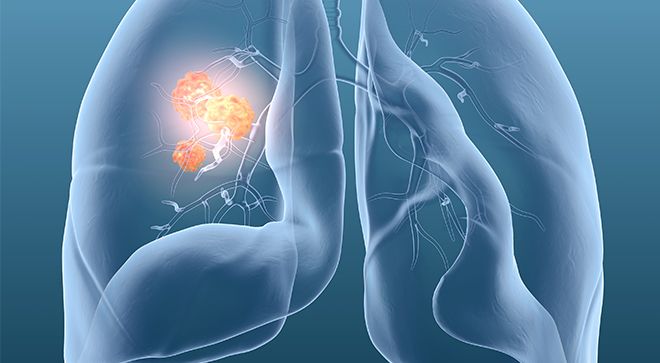‘Landmark’ Findings Led to Alecensa Approval for ALK-Positive NSCLC
Alecensa was shown to reduce the risk of disease recurrence or death by 76% versus chemotherapy for patients with ALK-positive non-small cell lung cancer.
Notably, Alecensa can enter the brain, which will help any brain metastases from ALK-positive lung cancer.

The approval by the Food and Drug Administration (FDA) of Alecensa (alectinib) to treat patients with ALK-positive non-small cell lung cancer (NSCLC) led to “landmark” results in the field, an expert said.
Eligible patients for Alecensa have a tumor of at least four centimeters that has been surgically removed. The approval of the drug was preceded by clinical trial findings from ALINA.
“The ALINA study, in my mind is a landmark study for early-stage non-small cell lung cancer, and specifically non-small cell lung cancer with the ALK gene fusion. The study is incredibly important because it shows that using the ALK inhibitor [Alecensa], for early-stage lung cancer after surgery, increases the survival rate of patients as compared to chemotherapy,” said Upal Basu Roy, executive director of research for the LUNGevity Foundation.
Alecensa was approved by the FDA based on the results of the phase 3 ALINA trial. Findings showed that adjuvant (postsurgical) treatment with Alecensa reduced the risk of disease recurrence or death by 76%. This was compared with chemotherapy treatment among patients with stage 1B to 3A ALK-positive early-stage resected (surgically removed) NSCLC with tumors measuring at least four centimeters.
“Among patients with resected ALK-positive NSCLC of stage 1B, 2 or 3A, adjuvant [Alecensa] significantly improved disease-free survival as compared with platinum-based chemotherapy,” researchers wrote in the New England Journal of Medicine.
“In patients with early stage, non-small cell lung cancer, even with chemotherapy, if you had stage 1B disease, 45% of the time the cancer came back,” said Roy. “If you had stage 3 disease, which is a larger tumor, and the tumor might be a little bit more spread, 76% of the time the cancer came back. But in the ALINA trial using this ALK drug [Alecensa], the percentage of patients who were alive and without disease after two years was 93.8%. And those patients who received chemotherapy, 63% of them were disease-free and alive at two years. So, it's a big, big, big difference in survival and disease-free state when [Alecensa], the ALK-inhibiting drug, is used.”
Alecensa is, according to manufacturer Genentech, the first ALK inhibitor approved for patients with ALK-positive early-stage NSCLC who have had surgery to remove their tumor.
Roy explained the science behind Alecensa, part of a class of drugs known as tyrosine kinase inhibitors.
“The ALK protein is a tyrosine kinase, and the ALK protein is normally switched off in normal lung cells,” Roy said. “But in lung cancer, what happens is the ALK gene may be fused to another gene, and commonly the EML4 gene, so you get an ALK-EML4 fusion. What this fusion does is it makes the ALK protein hyperactive in cancer cells — and when I say hyperactive, the cells get the signal to not stop growing, and they continue to grow all the time because of this ALK fusion protein. What [Alecensa] does is it blocks the activity of this mutant ALK protein and gives the cells the signal to stop growing and therefore controls the cancer.”
Importantly, Roy noted, Alecensa is also capable of entering the brain, “and ALK-positive lung cancer is very unique in that patients often will have brain metastases, even with early-stage disease, and the brain is often the site where the cancer shows up again. Now, because [Alecensa] can enter the brain by crossing the blood-brain barrier, you get a lot of protection.”
According to the FDA, the most common side effects among patients taking Alecensa were hepatotoxicity (liver damage), constipation, myalgia (muscle pain), COVID-19, fatigue, rash and cough.
The recommended dose of Alecensa is 600 milligrams taken orally with food twice daily for two years or until disease recurrence or unacceptable toxicity, according to the agency.
Still, Roy said, unmet needs persist, particularly among patients with earlier-stage disease.
“In this particular trial, patients who had stage 1B disease all the way to stage 3A disease, so small to large tumors, they were all included, but the analysis included stage 2 to stage 3A patients, so we still don't know if the really small tumors, for example, the stage 1B tumors, [if] those patients will benefit from [Alecensa],” Roy said. “Because at the end of the day, it's an extra drug and the drug causes side effects. So, we still don't know what the benefit of [Alecensa] is in that really small tumor size. Now building on that unmet need, we still need therapies for that group.”
Additionally, Roy said, there remains a group of early-stage patients whose disease will recur after treatment with Alecensa.
“Recurrence is common, and [Alecensa] is [also] used to treat metastatic or advanced stage non-small cell lung cancer will the ALK fusion. But if you're using [Alecensa] in the early-stage disease and if the cancer comes back, what's next for this group of patients?”
For more news on cancer updates, research and education, don’t forget to subscribe to CURE®’s newsletters here.